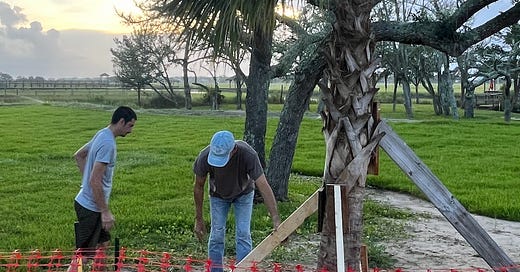"Why," asked Jessie, pushing on a freshly planted palmetto, "Do we have to stake them? They seem very well balanced." His black eyes sparkled with curiosity. Or sweat. It was only 6:25 in the morning, but we were already drenched. July is brutal on the coast of South Carolina. He went on, "If they fall over, couldn't we just push them back up?"
I took a deep breath, realizing that I could only partially answer. I’d always done it this way wouldn’t do. So I tried, "Palmetto roots sulk. I mean, when you cut one, even a little bit off the tip, that root dies. Other trees, you cut a root, and it stimulates even more roots. Palmettos don't. So we have to stake them to keep them up. Till they grow an entire new root system, if they fall over, the new roots will be damaged again, and it might have to start all over again. Besides, these things weigh 1500 pounds, and you might be young enough to push one back up, but I’m not about to."
Tom joined in, "But why? Why don’t they just grow new roots from the cut like other trees?" The three of us, on our palmetto staking mission, planned six hours for this job. We started early to beat the heat and the expected noon storm. We’d cut, nailed, and prepped the stakes last Saturday. We rolled out of the pickup, started work at 6 a.m., and watched a spectacular sunrise over the marsh. It’s beautiful, but the work is repetitive, and that sort of garden work leads to this kind of typical gardener conversation– the pondering of mysteries like palm physiology.
I paused, sighed, and gave a normal response when I couldn’t answer. "GTS," I said with a grin. "Google That Shit."
But the AI's answer left us wanting. It was like asking a question to a parrot. Try it. AI often simply rewords a question and throws in some other fancy words but doesn't say anything new. I have better resources, I thought and I went straight to the source. I sent a text to Wendy Wilber at the University of Florida.
"Hold on," Wendy said, "I'm confirming something in this book." She texted a photo of the book (photos and title at the end of this post), then a revelation.
"Palmettos lack the meristematic tissue that allows for regrowth. They simply cannot regrow because when you cut that tip, you've cut off all the cells in the root that are capable of growth."
If you have ever cut the top of a carrot or potato and stuck it in a cup of water then been amazed by its leaf and root growth from the old vegetable, you've seen meristematic tissue doing its thing. It's tissue that can change to a root, shoot, leaf, or flower at the drop of a pin. A young meristem cell becomes what that plant needs at any moment.
Palmetto roots, like adult humans, don't have many cells like that. Maybe it’s a weak comparison, but it’s like how reptiles can regrow a tail.
As we wrapped the burlap and webbed nylon strap around the last of the palmetto stakes, nature decided to join our philosophical discussion. A massive deep blue thunderstorm rolled in, pounding rain and throwing white lightning out over the steel gray Atlantic. Why? I wondered. Why is this storm ruining our work, and why don't palmetto roots have adaptability?
We found a dry spot. Everyone was quiet, so I did a little further reading. Why would a plant evolve such a risky strategy like this? I found a few theories in Google Scholar. Perhaps it's a gamble in sandy, drought-prone soils – sacrificing root regeneration for water conservation and leaf growth. Meristems take extra energy and water. Or maybe it's for survival, prioritizing a tightly knit root network that adds stability in a storm like this one over constant growth. Palmettos can live for three hundred years. Maybe, for a super long life, it's just better to stay upright than to have constant root growth and replacement.
But the why is still there. Sometimes, when we get into these sorts of discussions while working, I break out into the old song, "Why do fools fall in love? Why do birds sing so gay? And lovers await the break of day? Why do they fall in love?"
The lightning subsided. We’d been at this staking thing for 5 hours, and we were all dirty. But noble Jessie and I decided to get soaked and finish up while Tom arranged tools and towels for us inside the truck. Working down here on the coast, black silt gets all over you, but you don’t really see it till you’re wet, and it runs down your legs like octopus ink. The rain slowed. Octopus black rivuleted down my calves. Mosquitos swarmed. (Literally, watch the last scene in the video.)
It's in these moments I feel completely connected with earth, bugs, dirt, and the newly forming palmetto roots worming around in the muck just like we are. That’s the deep moment. Typical of gardener conversations, deep moments crash with absurdity frequently. I wonder, do they wonder about us? “Look at them,” the palmettos say, “Mobile and free. They have working legs. They could run away from this storm and the mosquito herd that is eating them alive. Why would they evolve like that? Flexible but stubborn. Mobile yet still here. And why are these three, these particular males together, drenched, muddy, listening for thunder, and still, they’re droning on about our roots? Why are they not somewhere cool and dry and falling in love? Fools.”







Ha! Humans do the oddest things.
And we don’t regrow thumbs, but we do have stem cells. These recurring patterns we see in the living (and non-living!) world are no accident.
Like octopus ink!